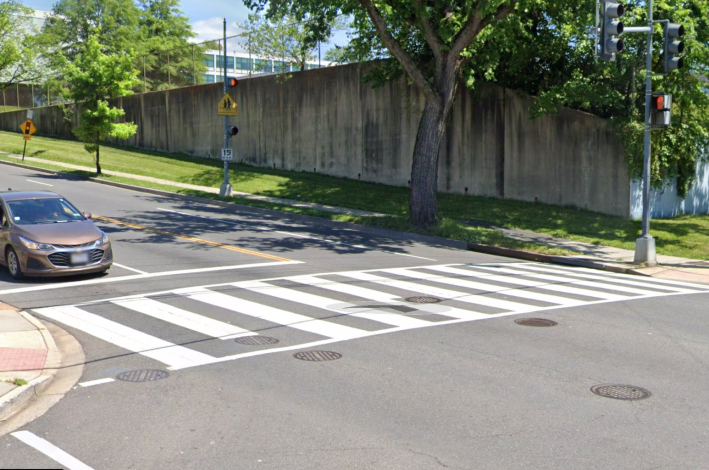A horrific crash on a street with an ultra-slow speed limit on National Walk to School Day is prompting advocates in Washington, D.C. to demand that District leaders add a sixth "E" to the the five "E's" in its Vision Zero approach: the exigency to radically reimagine District streets and put the safety of vulnerable road users first.
On Oct. 6, D.C. resident Tyrone Belton, 29, was completing his usual walk to school with his 6- and 8-year-old daughters, Heavyn and Faith White, when an unidentified driver of a Jeep turned into them at Mississippi and Wheeler avenues.
Warning; some of the content of the paragraphs and video below is graphic and disturbing.
Belton told local media (and added details on the family's GoFundMe page) about the horror of the crash: he suffered a broken angle from being dragged "almost 20 feet" by the driver, while 8-year-old Faith broke her leg so seriously that she will be confined to her bed for the duration of her recovery and 6-year-old Heavyn sustained major facial injuries that exposed a portion of her skull and will require extensive plastic surgery. The family is also coping with the emotional and psychological aftereffects of the traumatic incident, and Belton says all three will need significant therapy; he also added that Heavyn currently does not have health insurance.
The D.C. police has not yet said whether the driver will be charged.
#Exclusive: Tyrone Belton, 29, describes the moment he and his daughters were hit by car on #walktoschoolday. Hear his full story on @wusa9 and the long road to recovery he and his two daughters have ahead of them. https://t.co/AYyc41zz47 pic.twitter.com/KBiX0PeIWS
— Megan Rivers (@MegMRivers) October 10, 2021
The crash that tore the Belton family's lives apart was one of roughly 180,000 incidents of traffic violence that injures a child on an American road each year, about 8 percent of which involve a child on foot.
But this one was distinct in two key ways: it happened on the day of a major annual pedestrian safety event that (at least in theory) should have alerted drivers to the strong probability of encountering kids on foot, and it happened at an intersection that already featured a significant number of infrastructure improvements designed to protect walkers — infrastructure that nonetheless were insufficient to stop a reckless driver.
Those two facts have led some advocates to point out that preventing future crashes will take more than signage, paint, and sunny public awareness campaigns.
"We're saddened, but it's not particularly surprising," said Colin Browne, communications director for the Washington Area Bicyclists Association. "At the end of the day, it's still an intersection of two overbuilt roads. Advocates have been fighting for a bigger road diet on that section of Mississippi Avenue for several years that's been stalled for political reasons — and even with the improvements we've already got, reckless driving is only increasing around the country. I don't think our street design professionals have caught up yet."

The October 6 crash isn't the first time that DC advocates have accused District leadership of slow-walking their way to the city's Vision Zero goals — and it's certainly not the first time a child has been harmed by a driver on D.C. roads this year.
Just weeks ago, the death of 5-year-old Allison Hart and another serious crash involving 4-year-old Nathan Ballard-Means — both of whom were struck by the drivers of large vehicles while riding their bikes at intersections — prompted a consortium of local advocates (including the Bicycle Association) to send D.C. leadership an open letter demanding urgent action. In 2015, Mayor Muriel Bowser announced an appropriately aggressive goal to end roadway deaths by 2024, but the community has experienced increases in deaths in five of the six years since; its Vision Zero program is now the subject of a formal audit.
"In the wake of the 185th traffic death in the past six years, we aren’t asking for more funding or more planning for infrastructure," the advocates wrote. "[But] on street after street, project after project, the District drags its feet, implementing proven safety measures only reluctantly and after aggressive compromise...We are asking for an ideology of safety from those leading the District. We want to see, and feel, that Mayor Bowser cares more about safety than parking, more about safety than driving fast, and more about safety than driver convenience."
Mayor Bowser announced on Tuesday that she would streamline an onerous process that required a 130-day traffic study before road diet measures can be considered, but the declaration did not come soon enough for Faith, Heavyn and their father.
As many of may know, there was a terrible traffic accident involving two little girls & their father en route to school today. Last month I advised @DDOTDC about the traffic concerns in this corridor. I was told that it would take 130 days to complete the traffic study. pic.twitter.com/4LilIuaVYE
— Salim Adofo (@salimadofo) October 6, 2021
Of course, an "ideology of safety" is missing from more U.S. communities than just the nation's capital. Other large urban centers with the resources to reimagine their transportation systems have failed to act with the urgency their traffic violence crises demand — like New York City, which has experienced an average of 728 car crashes on the first day of school every year since 2014.
Browne says it's unconscionable that the richest cities in America are still stalling the transformative change that vulnerable road users need — and even less wealthy and powerful communities can save more lives than they might assume.
"Traffic calming is not expensive, and it doesn't have to involve moving large chunks of concrete," Browne adds. "[But even with all the money in the world], there's still a fundamental cultural resistance to change. At the end of the day, safe streets advocacy works, especially at an extremely grassroots level when neighbors get organized. It just takes time and work."
Browne stresses that the work it would take to prevent future crashes like the one Tyrone Belton and his daughters suffered isn't always easy, but not doing it is inexcusable — especially in D.C., which "has the resources, the tools, and the expertise to make every intersection in this city safe for people," as the authors wrote in the open letter.
And he's not the only advocate who thinks D.C., and every city like it, could be doing more.
"During the pandemic, we’ve learned from communities [across the U.S.] about all the ways they’re trying to make streets around schools safer for walking and biking every day, such as limiting vehicles arriving on the school campus, offering multiple entrances to make pathways usable routes to the school, and accelerating the timeline of safe infrastructure projects," said Nancy Pullen-Seufert, director of National Center for Safe Routes to School, which organizes Walk to School Day. "Creating pedestrian friendly streets for all ages takes time, but we do know how to do it."
Browne stresses that those kinds of interventions must be implemented on every road a child might walk — and it should be done before crashes happen, rather than after tragedy has already struck.
"If D.C. had a real ideology of safety, the city would be thinking about it not as how do we address the aftermath of this one crash, but how do we fundamentally change the way that people move through our city? How do we solve these problems before they happen?"







